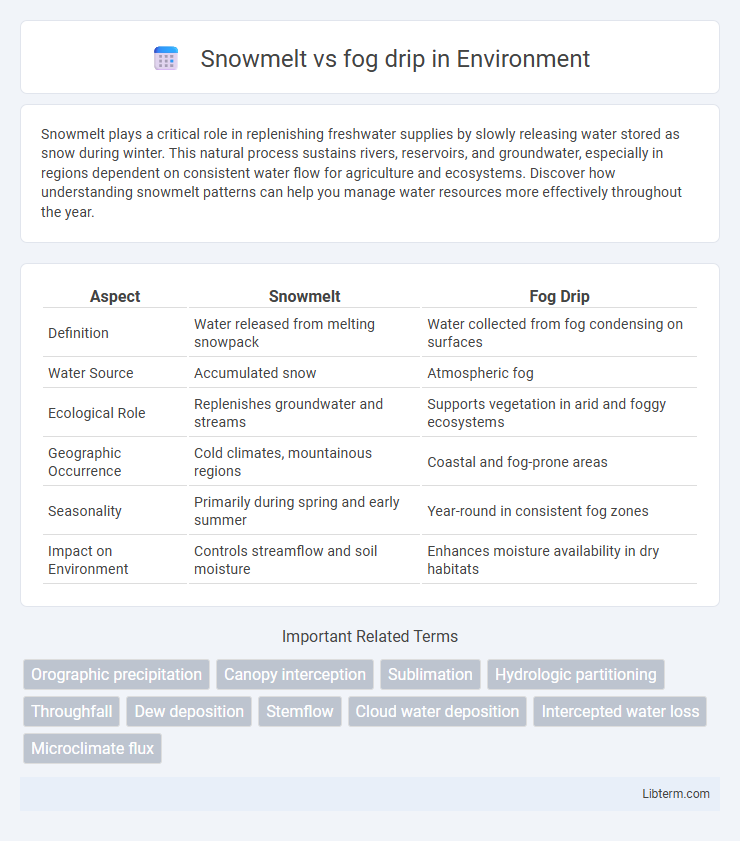Snowmelt plays a critical role in replenishing freshwater supplies by slowly releasing water stored as snow during winter. This natural process sustains rivers, reservoirs, and groundwater, especially in regions dependent on consistent water flow for agriculture and ecosystems. Discover how understanding snowmelt patterns can help you manage water resources more effectively throughout the year.
Table of Comparison
| Aspect | Snowmelt | Fog Drip |
|---|---|---|
| Definition | Water released from melting snowpack | Water collected from fog condensing on surfaces |
| Water Source | Accumulated snow | Atmospheric fog |
| Ecological Role | Replenishes groundwater and streams | Supports vegetation in arid and foggy ecosystems |
| Geographic Occurrence | Cold climates, mountainous regions | Coastal and fog-prone areas |
| Seasonality | Primarily during spring and early summer | Year-round in consistent fog zones |
| Impact on Environment | Controls streamflow and soil moisture | Enhances moisture availability in dry habitats |
Introduction to Snowmelt and Fog Drip
Snowmelt refers to the process where accumulated snow melts and infiltrates the soil, providing essential moisture to ecosystems and replenishing groundwater supplies. Fog drip occurs when water vapor condenses on vegetation surfaces, such as leaves and needles, and drips to the ground, contributing significant moisture in fog-prone environments. Both processes play critical roles in maintaining water balance and supporting plant growth in diverse habitats.
Definitions: What is Snowmelt? What is Fog Drip?
Snowmelt refers to the process where accumulated snow on the ground melts into liquid water, significantly influencing groundwater recharge and streamflow in mountainous and temperate regions. Fog drip occurs when water droplets in fog condense on vegetation such as tree leaves and branches, eventually dripping to the forest floor and contributing to local moisture and ecosystem hydration. Both processes are critical components of the hydrological cycle, affecting water availability and ecological conditions in various environments.
Formation Processes: Snowmelt vs Fog Drip
Snowmelt forms when accumulated snowpack absorbs enough heat to melt, causing liquid water to flow downhill or infiltrate the soil. Fog drip occurs when water vapor in fog condenses on vegetation surfaces, such as tree leaves and branches, eventually dripping to the ground. The primary difference lies in snowmelt relying on temperature-induced phase change of ice to liquid, whereas fog drip depends on atmospheric moisture condensation directly onto surfaces.
Geographic Distribution and Occurrence
Snowmelt primarily occurs in mountainous and temperate regions with seasonal snowfall, such as the Rocky Mountains and the Sierra Nevada, where accumulated snowpack melts during warmer months. Fog drip predominantly takes place in coastal and cloud forest areas like the Pacific Northwest and parts of California, where persistent fog condenses on vegetation, contributing to moisture input. Each phenomenon plays a crucial role in sustaining local ecosystems by influencing water availability in regions characterized by distinct climatic and geographic conditions.
Hydrological Impact Comparison
Snowmelt contributes significantly to river flow and groundwater recharge by delivering a gradual release of water during thaw periods, essential for maintaining stream ecosystems and water supply in temperate regions. Fog drip generates localized moisture through condensation on vegetation, enhancing soil moisture and supporting ecosystem resilience in arid and coastal environments with limited rainfall. The hydrological impact of snowmelt is typically larger in scale and seasonal duration, while fog drip provides critical, though spatially limited, water input during dry spells.
Influence on Local Ecosystems
Snowmelt provides a steady and prolonged water source crucial for replenishing groundwater and supporting plant growth during dry seasons, thus sustaining biodiversity in alpine and subalpine ecosystems. Fog drip captures moisture from fog, delivering localized hydration that benefits canopy vegetation and maintains microhabitats essential for epiphytes and moisture-dependent fauna. Together, snowmelt and fog drip create complementary hydrological inputs that stabilize water availability and enhance resilience in diverse ecosystems.
Measuring Snowmelt and Fog Drip
Measuring snowmelt involves using snow pillows and lysimeters to quantify water released as snow transitions to liquid, providing insights into watershed input and soil moisture recharge. Fog drip measurement relies on throughfall collectors and mesh screens that capture water droplets condensed from fog, crucial for understanding moisture input in cloud forests and arid environments. Accurate data from these methods informs hydrological models and supports ecosystem water balance assessments.
Climate Change Effects on Snowmelt and Fog Drip
Climate change accelerates snowmelt rates by raising average temperatures and altering precipitation patterns, reducing the seasonal snowpack critical for water storage. Fog drip, dependent on coastal fog frequency and vegetation, faces unpredictability as shifting climate conditions disrupt fog formation and distribution. These changes impact ecosystem water availability and hydrological cycles, increasing risks of drought and affecting plant and animal communities reliant on consistent moisture sources.
Importance in Water Resource Management
Snowmelt and fog drip are critical components of water resource management, particularly in mountainous and coastal ecosystems where they contribute significantly to groundwater recharge and streamflow. Snowmelt provides a predictable, seasonal influx of water essential for agriculture, hydropower, and urban water supplies, while fog drip supplements moisture in arid and semi-arid regions by capturing atmospheric water directly to vegetation and soil. Effective integration of snowmelt and fog drip data enhances water budgeting, drought mitigation strategies, and ecosystem resilience in the face of climate variability.
Key Differences and Similarities
Snowmelt and fog drip both contribute to water input in ecosystems, but snowmelt originates from melting snowpack, while fog drip results from condensation of fog on vegetation. Snowmelt provides a gradual release of water during thaw periods, significantly influencing streamflow and soil moisture, whereas fog drip offers localized moisture deposition, often benefiting arid or coastal environments. Both processes enhance soil hydration and support plant growth, though their occurrence depends on distinct climatic conditions and geographic features.
Snowmelt Infographic

 libterm.com
libterm.com